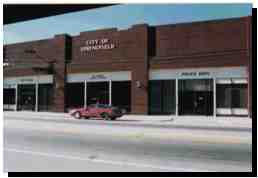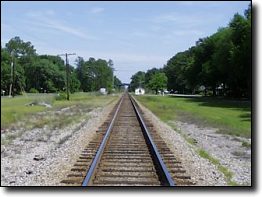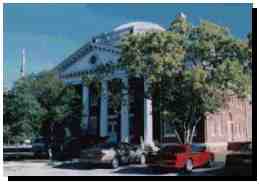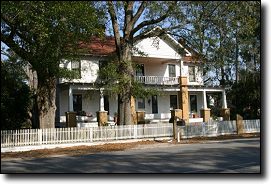 |
||||
|
City of Springfield
The county government surveyed the new
town, and designated streets, lots, and the public squares that were
to be used for the courthouse and the jail. The lots were sold to
finance the construction of these public buildings. A map drawn in
1821 shows four north - south streets and nine east - west streets.
Development of the new county seat was slow. At the turn of the
century, it was listed as having only about twelve houses.
Much of the early architecture was lost due to a series of fires from the late 1800s through the 1960s. This loss should serve to underline the importance of the courthouse and its surrounding residential structures. Courthouse Square
Stylistically, American Government buildings have evolved within the realm of classical Greek architecture. As the United States was searching for identity, the association with Greek Democracy became translated into the architectural styles of governmental buildings. Greek proportions and ornamentation remain a symbol of the solidity of government through association with Greek democracy. Springfield's 1908 courthouse is an example of the courthouse as town anchor. At the turn-of-the-century the Effingham County Courthouse was a two-story frame building facing Early Street. The lower floor contained the court room and a few offices. The second floor was the Jury Room. In 1908, the present courthouse was built, designed by Savannah architect Hyman W. Witcover. In 1979 an annex was added for additional space. By this time the courthouse was much more than a building in which to hear legal matters. County business expanded requiring space for offices such as the Tax Assessor, the Tax Collector, and the County Commissioners. Also located in the courthouse was the Probate Court, which administered wills and testaments and looked after orphans and widows. Here also was the Magistrate's Court which ruled on both criminal and civil cases. Styles of ArchitectureJust as clothing follows the current fashion, architecture also follows fashion or is said to be of a "style." Springfield experienced its major growth around 1910. During that period the architectural fashion was shifting from the elaborate and highly detailed Victorian style to the simpler and more sensible Arts and Crafts or Bungalow style. The majority of Springfield's historic homes reflect this architectural style. This transitional fashion is often referred to as Folk Victorian. It is recognizable by the use of spindle work around eaves and porches, decorative porch supports, patterned shingles in the gables and single-paned, double hung windows. Southern House Types
Interior elements which contribute to climate control are the high ceilings and double hung windows. On warm days the upper window sash can be lowered to allow the hot air to escape, while cool air is drawn in the raised lower window sash. These elements coupled with thick plaster walls create a comfortable environment. Another coastal condition is heavy rain. Therefore, most roofs are steeply pitched to improve roof drainage. In Springfield many of the historic roofs are of metal to further increase their ability to shed rain and, also, to prevent the spread of fire from one structure to the next. Springfield was historically a sawmill town. Thus lumber was easily accessible, explaining the predominance of wooden frame houses. The majority of the historic homes were constructed before the automobile, which explains the lack of original carports or garages. Due to the ravages of fire, time, and progress, many of the earliest structures of Springfield have been lost. Fortunately the original 1908 Effingham County Courthouse and its surrounding residential neighborhood remain. If these buildings are not recognized for their architectural and historical importance, they too are in danger of being lost. By recognizing and appreciating what structures are left, the residents can insure that these historic buildings surrounding the original Courthouse Square remain intact. All that is left should be recognized and preserved for the enjoyment and the education of future generations. The built history of this small Southern town, rural county seat and lumber mill community, is a heritage that must be guarded. With the rapid growth and development of Effingham County, the next generation could know a Springfield very different from what it was historically. Only the present citizens can assure that the traditional buildings of Springfield continue into the future, to join the past with the present. Effingham County |
Effingham Real Estate |
Attractions |
|
||
|
|
||||
|
|
||||
 Today,
Springfield is the seat of government for Effingham County. But, it
hasn't always been that way. In 1799, Effingham County had three
different county seats. The state legislature appointed a commission
to select a new centrally located site for the permanent county seat.
A location five miles from the center of the county was chosen and
named Springfield.
Today,
Springfield is the seat of government for Effingham County. But, it
hasn't always been that way. In 1799, Effingham County had three
different county seats. The state legislature appointed a commission
to select a new centrally located site for the permanent county seat.
A location five miles from the center of the county was chosen and
named Springfield.
 But a 1907 map showed the introduction of the railroad, four new east
- west streets, and several new north - south streets. This time
period saw the greatest growth in Springfield. The Brinson Railroad
from Savannah was built about 1907, as was the George M. Brinson
Sawmill. In 1908 the present County Courthouse was constructed. In the
decade from 1900 to 1910, the population of Springfield increased to
500 from 134.
But a 1907 map showed the introduction of the railroad, four new east
- west streets, and several new north - south streets. This time
period saw the greatest growth in Springfield. The Brinson Railroad
from Savannah was built about 1907, as was the George M. Brinson
Sawmill. In 1908 the present County Courthouse was constructed. In the
decade from 1900 to 1910, the population of Springfield increased to
500 from 134.
 Throughout the South, the courthouse square served as the nucleus of
town activity and the anchor around which the community was planned.
The courthouse was usually surrounded by public space or by a square.
Houses emerged on the fringes of the square and growth would usually
radiate from the courthouse, creating a square town plan. Springfield
is a good example of this process.
Throughout the South, the courthouse square served as the nucleus of
town activity and the anchor around which the community was planned.
The courthouse was usually surrounded by public space or by a square.
Houses emerged on the fringes of the square and growth would usually
radiate from the courthouse, creating a square town plan. Springfield
is a good example of this process.
 The
Historic homes of Springfield were designed to adapt to coastal
Georgia's warm environment. Most houses were built on raised
foundations to reduce rising heat from the ground, as well as to allow
for ventilation to eliminate dampness. Windows were strategically
placed to capture the cool evening breeze and to provide cross
ventilation. The exaggerated eaves and porches divert the direct sun
which reduces the absorption of heat, in addition to providing an
outdoor living area.
The
Historic homes of Springfield were designed to adapt to coastal
Georgia's warm environment. Most houses were built on raised
foundations to reduce rising heat from the ground, as well as to allow
for ventilation to eliminate dampness. Windows were strategically
placed to capture the cool evening breeze and to provide cross
ventilation. The exaggerated eaves and porches divert the direct sun
which reduces the absorption of heat, in addition to providing an
outdoor living area.